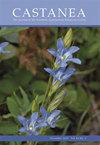Modeling Habitat Suitability for Stewartia ovata Across the Southeastern United States
IF 0.3
4区 生物学
Q4 PLANT SCIENCES
引用次数: 1
Abstract
ABSTRACT Mountain stewartia (Stewartia ovata) is a rare shrub or small tree endemic to the higher elevation regions of Georgia, Tennessee, and Alabama with isolated populations occurring in Kentucky, North Carolina, South Carolina, Virginia, and Mississippi. The species is often misidentified or overlooked by land managers and conservationists. As a result, mountain stewartia's habitat and distribution descriptions are limited for restoration and conservation use. Modeling a species' habitat suitability has become a critical first step in conserving rare and imperiled plant species. These models allow conservationists to locate previously undocumented populations and prioritize populations and habitats for conservation. This study presents a habitat suitability model for mountain stewartia across its known natural range based on maximum entropy (Maxent) modeling with nine environmental predictor variables and 60 occurrences from herbarium records (n=22), research-grade iNaturalist observations (n=25), and other author identified locations (n=3). The resulting habitat suitability map was classified into bins for spatial analysis. A total of 376,030 ha (0.44% of the study area) was designated within the top tier bin with the highest suitable habitat. Further, 133,344 ha (0.16% of the study area) of the top bin was found on publicly owned lands, indicating approximately 35.56% of the highest habitat suitability occurs within public lands. The presented model could allow plant conservationists to prioritize areas for conservation, reintroduction, and may lead to the discovery of previously undocumented populations.美国东南部野樱草生境适宜性模拟
山甜菊(stewartia ovata)是一种罕见的灌木或小树,特有种于乔治亚州、田纳西州和阿拉巴马州的高海拔地区,在肯塔基州、北卡罗来纳州、南卡罗来纳州、弗吉尼亚州和密西西比州也有孤立的种群。该物种经常被土地管理者和自然资源保护主义者错误识别或忽视。因此,山管家草的生境和分布描述限制了恢复和保护利用。建立物种栖息地适宜性模型已成为保护珍稀濒危植物物种的关键第一步。这些模型使自然资源保护主义者能够定位以前未记录的种群,并优先考虑保护的种群和栖息地。本研究基于最大熵(Maxent)模型,利用植物标本馆记录(n=22)、研究级自然学家观测(n=25)和其他作者确定的地点(n=3)中的60个环境预测变量和最大熵(Maxent)模型,建立了一个已知自然范围内山地野田鼠属植物的栖息地适宜性模型。将得到的生境适宜性图划分为箱型进行空间分析。在最适宜生境的顶层箱内,共有376,030 ha(占研究面积的0.44%)。此外,在公共土地上发现了133,344 ha(占研究面积的0.16%)的顶部bin,表明大约35.56%的最高生境适宜性发生在公共土地上。提出的模型可以让植物保护主义者优先考虑保护和重新引入的区域,并可能导致发现以前未记录的种群。
本文章由计算机程序翻译,如有差异,请以英文原文为准。
求助全文
约1分钟内获得全文
求助全文
来源期刊

Castanea
生物-植物科学
CiteScore
0.50
自引率
25.00%
发文量
28
审稿时长
>12 weeks
期刊介绍:
Castanea is named in honor of the American Chestnut tree. Castanea is thebotanical name for Chestnuts, dating back to what the ancient Greeks calledthem.
The American Chestnut is a critically endangered tree that once made up 35%of the forests of the Eastern US before being devastated by a blight thatdestroyed up to 4 billion American Chestnut trees.
Castanea serves professional and amateur botanists by reviewing andpublishing scientific papers related to botany in the Eastern United States.
We accept papers relating to plant biology, biochemistry, ecology, floristics,physiology and systematics.
 求助内容:
求助内容: 应助结果提醒方式:
应助结果提醒方式:


